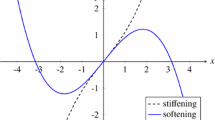Abstract
The solution to the softening Duffing differential equation \({\ddot{x}}+2\beta {\dot{x}}+\alpha x-\varepsilon x^{3}=0\), for an unforced system with damping is described in terms of the Jacobi elliptic functions. The parameter of the Jacobi elliptic functions is allowed to be time-dependent and the analytical solution is found to be accurate compared to the numerical one. An explicit expression for the the period of oscillation is derived and found to be longer initially, however gradually decreasing to that of a linearized model.





Similar content being viewed by others
References
Guckenheimer, J., Homes, P.: Nonlinear Oscillations. Dynamical Systems and Bifurcation of Vector Fields. Springer, New York (1983)
Lawden, D.F.: Elliptic Functions and Applications. Applied Mathematical Sciences, vol. 60. Springer, New York (1989)
Kovacic, I., Brennan, M.J.: The Duffing Equation Nonlinear Oscillations and their Behavior. Wiley, New York (2011)
Bakhtiari-Nejad, F., Nazari, M.: Nonlinear vibration analysis of isotropic cantilever plate with viscoelastic laminate. Nonlinear Dyn. 56, 325–356 (2009)
Nayfeh, A.H.: Problems in Perturbations. Wiley, New York (1985)
Krylov, N., Bogoliubov, N.: Introduction to Nonlinear Mechanics. Annals of Mathematics Studies. Princeton University Press, Princeton (1947)
Christopher, P.A.T.: An approximate solution to a strongly nonlinear, second order, differential equation. Int. J. Control 17, 597–608 (1973)
Amore, P., Raya, A., Fernández, F.M.: Alternative perturbation approaches in classical mechanics. Eur. J. Phys. 26, 1057–1063 (2005)
Amore, P., Aranda, A.: Improved Lindstedt–Poincaré method for the solution of nonlinear problems. J. Sound Vib. 283, 1115–1136 (2007)
Yuste, S.B., Bejarano, J.D.: Extension and improvement to the Krylov–Bogoliubov method using elliptic functions. Int. J. Control 49, 1127–1141 (1987)
Yuste, S.B., Bejarano, J.D.: Amplitude decay of damped nonlinear oscillators studied with Jacobian elliptic functions. J. Sound Vib. 114(1), 33–44 (1987)
Yuste, S.B.: On Duffing oscillators with slowly varying parameters. Int. J. Nonlinear Mech. 5, 671–677 (1991)
Yuste, S.B.: Comments on the method af harmonic balance in which Jacobi elliptic functions are used. J. Sound Vib. 145, 381–390 (1991)
Chen, S.H., Cheung, Y.K.: An elliptic perturbation method for certain strongly nonlinear oscillators. J. Sound Vib. 192, 453–464 (1996)
Chen, S.H., Cheung, Y.K.: An elliptic Lindstedt–Poincaré method for analysis of certain strongly nonlinear oscillators. Nonlinear Dyn. 12, 199–213 (1997)
Liao, S.J., Chwang, A.T.: Application of homotopy analysis method in nonlinear oscillations. ASME J. Appl. Mech. 65, 914–922 (1998)
He, J.H.: Homotopy perturbation technique. Comput. Methods Appl. Mech. Eng. 178, 257–262 (1999)
He, J.H.: Some asymptotic methods for strongly nonlinear equations. Int. J. Mod. Phys. B 20, 1141–1199 (2006)
Belendez, A., Hernández, A., Beléndez, T., Alvarez, M.I., Gallego, S., Ortuno, M., Neipp, C.: Application of the harmonic balance method to a linear oscillator typified by a mass attached to a streched wire. J. Sound Vib. 302, 1018–1029 (2007)
Beléndez, A., Méndez, D.I., Fernández, E., Marini, S., Pascual, I.: An explicit approximate solution to the Duffing-harmonic oscillator by a cubication method. Phys. Lett. A 373, 2805–2809 (2009)
Whittaker, E.T., Watson, G.N.: A Course of Modern Analysis, 4th edn. University Press, Cambridge (1980)
Abramowitz, M., Stegun, I.: Handbook of Mathematical Functions, 9th edn. Dover, New York (1980)
Walker, P.: The analyticity of Jacobian functions with respect to the parameter \(k\). Proc. R. Soc. Lond. A 459, 2569–2574 (2003)
Johannessen, K.: An analytical solution to the equation of motion to the damped nonlinear pendulum. Eur. J. Phys. 35, 035014 (2014)
Johannessen, K.: The Duffing oscillator with damping. Eur. J. Phys. 36, 065020 (2015)
Author information
Authors and Affiliations
Corresponding author
Appendix: The Derivation of the Function \(\xi (u)\)
Appendix: The Derivation of the Function \(\xi (u)\)
In this section the scaling function \(\xi (u)\) is derived such that the relationsship:
is fulfilled for any value of the variable u [24, 25]. The function f(u) is for small values of the elliptic parameter approximately given by \(f(u)\cong (\frac{1}{4}m(u)+\frac{9}{32}m(u)^{2}) u\) [24, 25], and the elliptic parameter m is in the present case given by Eq. (12):
It is seen, that with increasing values of u the elliptic parameter varies between the maximum value of \(m(0)=a/{(1-a)}\) towards zero value.
From Eq. (21) one now finds that:
Using integration by parts this gives:
By use of the substitution, \(v=1-a e^{-2 \gamma u}\), both of these integrals are easily evaluated and one finds that:
Finally, the constant of integration is found from the criteria, that \(\xi (0)=0\), and thus an expression for the parameter scaling expression \(\xi (u)\) is:
In the limit of \(\gamma \rightarrow 0\) we have \(\xi (u)\rightarrow u\) as expected, which can readily be verified by use of the theorem by L’Hospital.
Rights and permissions
About this article
Cite this article
Johannessen, K. The Duffing Oscillator with Damping for a Softening Potential. Int. J. Appl. Comput. Math 3, 3805–3816 (2017). https://doi.org/10.1007/s40819-017-0333-5
Published:
Issue Date:
DOI: https://doi.org/10.1007/s40819-017-0333-5



